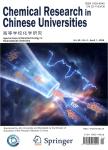Removing Cd^(2+) by Composite Adsorbent Nano-Fe_3O_4/Bacterial Cellulose
Removing Cd^(2+) by Composite Adsorbent Nano-Fe_3O_4/Bacterial Cellulose作者机构:School of Chemical Engineering Northeast Dianli University Jilin 132012 P. R. China School of Resources & Civil Engineering Northeastern University Shenyang 110004 P. R. China
出 版 物:《Chemical Research in Chinese Universities》 (高等学校化学研究(英文版))
年 卷 期:2011年第27卷第6期
页 面:1031-1034页
核心收录:
学科分类:081702[工学-化学工艺] 081704[工学-应用化学] 07[理学] 08[工学] 0817[工学-化学工程与技术] 070305[理学-高分子化学与物理] 080501[工学-材料物理与化学] 0805[工学-材料科学与工程(可授工学、理学学位)] 0703[理学-化学]
基 金:Supported by the National Natural Science Foundation of China(No.50174014)
主 题:Nano-Fe3O4 Bacterial cellulose Composite adsorbent Cadmium ion
摘 要:A new composite adsorbent, nano-Fe3O4/bacterial cellulose(BC), was prepared through blending method. The process of adsorbing Cd2+ including its isotherm and kinetics measured was studied. The results show that the adsorption efficiency is improved because of huge surface area and surface coordination of nano-Fe3O4 particles. Its adsorption capacity is 27.97 mg/g and the maximum of Cd2+ removal is 74%. The adsorption kinetics can be described by pseudo-second rate model and the adsorption equilibrium by Langmuir type. The superparamagnetism of nano-Fe3O4 particles can help to solve the difficult separation of single BC adsorbent and lead to the quick separation of composite adsorbent from the liquid if a magnetic field was applied. Cd2+ can be desorbed effectively by EDTA and HCl from the composite adsorbent, which can make it be reused.



